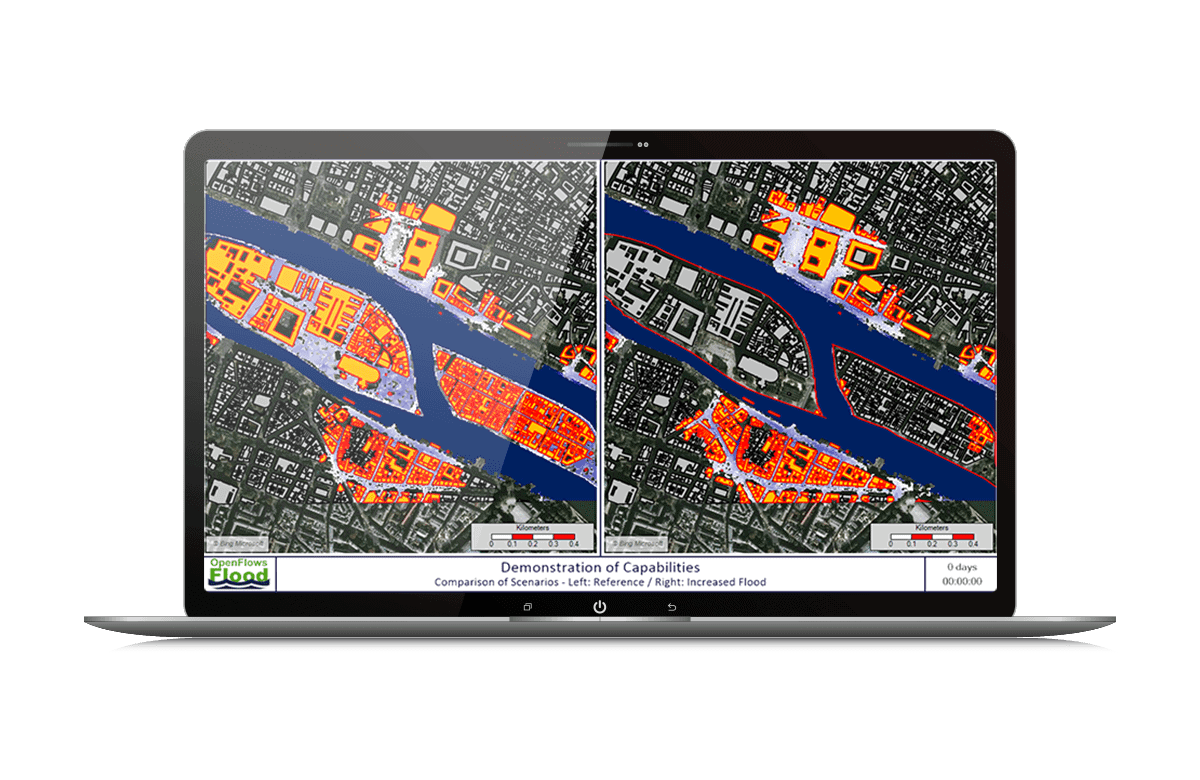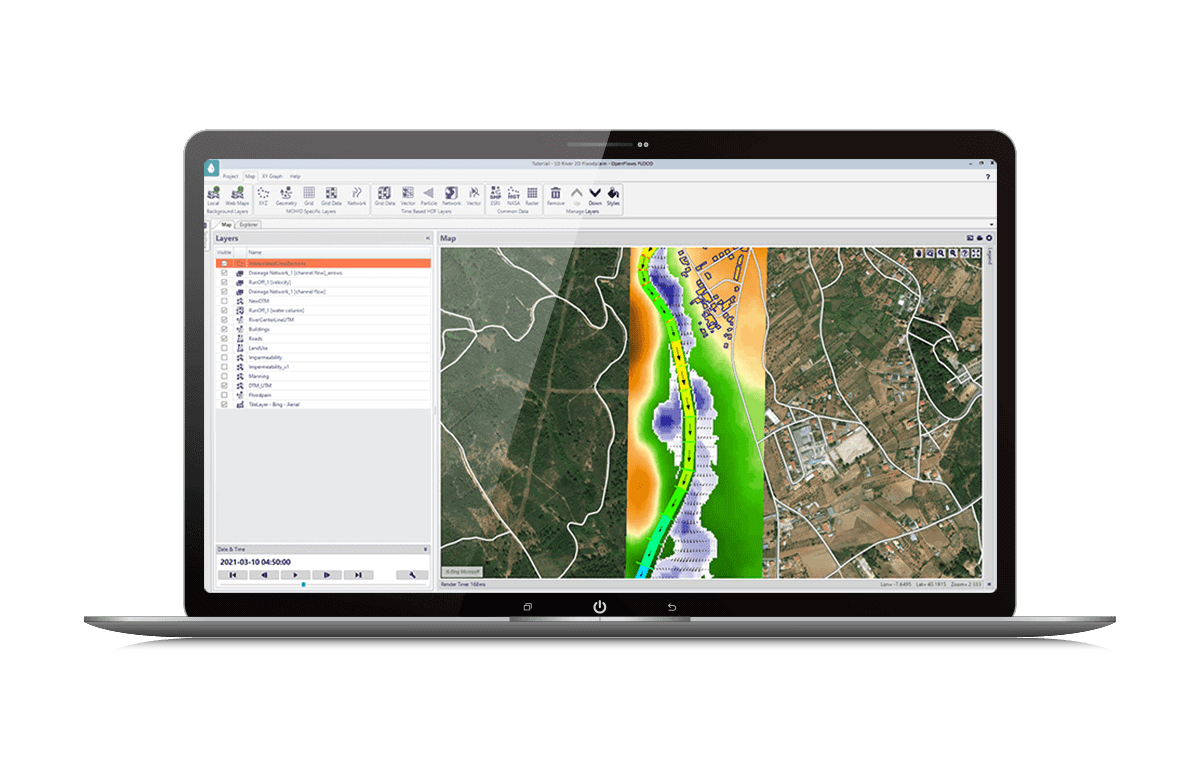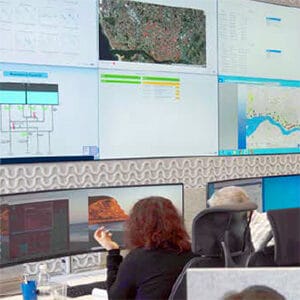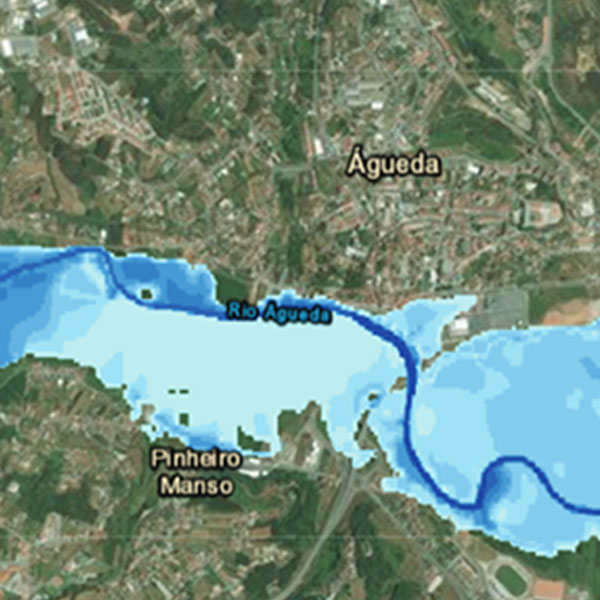Flood Risk Assessment And Mitigation
What Is OpenFlows FLOOD?
OpenFlows FLOOD uses fully spatially-distributed numerical models to simulate all hydrological and hydraulic processes that occur in river basins, including rainfall, infiltration, surface runoff, channel flow, and groundwater flow. In urban areas, OpenFlows FLOOD can be connected to a model generated by OpenFlows SewerGEMS to simulate the surface and stormwater flow. Additionally, the model can be used to simulate flooding in coastal areas due to storm surges.
- Mitigate Flood Risks
-
Mitigate Flood Risks in Urban, Riverine, and Coastal Areas
Spatially Distributed Numerical Models
Simulate all hydrological and hydraulic processes that occur in river basins including rainfall, infiltration, surface runoff, channel flow, and groundwater flow.
Leverage Real-world Digital Context and Visualization
Using a 3D reality mesh from ContextCapture, you can bring simulations to life by generating realistic visualizations of flood events.
Quickly Find the Best Solution for Flood Risk Mitigation
Use scenario management to easily make comparisons among different alternatives.
- Build and Manage Models
-
Jumpstart the Model-building Process
Import many well-known external data formats
Automate input data generation and maximize ROI on existing geospatial and engineering data.
Calculate River Flows and Surface Runoff
Prepare spatial data and use different modeling approaches to simulate surface runoff, the exchange of water between the river, the floodplain, and (sub)surface flow using fully integrated 1D-2D grid.
Simulate Flooding in Urban Areas
Evaluate water flows in the piped subsurface network, river, and coastal systems, as well as the surface flow and the exchange of water between systems.

Mitigate Flood Risks in Urban, Riverine, and Coastal Areas
Spatially Distributed Numerical Models
Simulate all hydrological and hydraulic processes that occur in river basins including rainfall, infiltration, surface runoff, channel flow, and groundwater flow.
Leverage Real-world Digital Context and Visualization
Using a 3D reality mesh from ContextCapture, you can bring simulations to life by generating realistic visualizations of flood events.
Quickly Find the Best Solution for Flood Risk Mitigation
Use scenario management to easily make comparisons among different alternatives.

Jumpstart the Model-building Process
Import many well-known external data formats
Automate input data generation and maximize ROI on existing geospatial and engineering data.
Calculate River Flows and Surface Runoff
Prepare spatial data and use different modeling approaches to simulate surface runoff, the exchange of water between the river, the floodplain, and (sub)surface flow using fully integrated 1D-2D grid.
Simulate Flooding in Urban Areas
Evaluate water flows in the piped subsurface network, river, and coastal systems, as well as the surface flow and the exchange of water between systems.
- 2x
- 1.75x
- 1.5x
- 1.25x
- 1x, selected
- 0.75x
- 0.5x
- Chapters
- descriptions off, selected
- captions settings, opens captions settings dialog
- captions off, selected
This is a modal window.
Beginning of dialog window. Escape will cancel and close the window.
End of dialog window.
This is a modal window. This modal can be closed by pressing the Escape key or activating the close button.
This is a modal window. This modal can be closed by pressing the Escape key or activating the close button.
OpenFlows FLOOD
- Analyze and mitigate flood risks in urban, riverine, and coastal areas
- Simulate hydrological and hydraulic processes to support emergency planning and calculate and analyze flood inundation areas
User Quote
Bentley software produced a digital twin model of the city's water supply, wastewater, stormwater, and bathing water systems, to forecast flooding and water quality issues, thereby improving city response and resilience.
—Pedro Vieira, Águas do Porto, Portugal
Featured User Stories
Águas do Porto
Monitors Water System in Real Time
Bentley’s software helped build a unified management program to access data in the field, producing operation gains of 25%.
PORTUGUESE ENVIRONMENTAL AGENCY
Flood Risk Management
OpenFlows FLOOD helps quantify the most critical flood-prone areas in Portugal
Aqua+
Delivers Water Treatment Plant Project Documentation
Increases Plant Control System Design Speed by 50 Percent with Promis.e.
FAQs
FLOOD is flood modeling software for analyzing and mitigating flood risk in urban, riverine, and coastal areas. Using spatially distributed numerical models, users can quickly simulate all hydrological and hydraulic processes to support emergency planning and green-initiative design. Apply a multi-scale 1D/2D approach to support flood early warning systems (FEWS).
The price of OpenFlows FLOOD varies per region. While there are various types of licensing available, a common choice is the 12-month practitioner license offered through Bentley’s eStore. When you purchase through the eStore, you get a Virtuoso Subscription. This means you get the software and “Keys” (tokens) to redeem for customizable training, mentoring, and consulting services.
All the equations and numerical methods, and source code from the 2D flood model (MOHID) is available online. This is a collaborative, free, opensource “model.” HEC-RAS is free, but not open-source which means that an advanced user is not able to check source code or modify it.
FLOOD numerical solver (MOHID) was analyzed for comparison with a benchmark study from UK Environment Agency. This methodology has been adopted as the world reference for benchmarking 2D flood modeling. FLOOD results are compatible with most solutions.
FLOOD can be used as a single tool for an integrated 2D flood model, while HEC-RAS does not have direct rain-on-grid, infiltration, or evapotranspiration. You would need an additional tool called HEC-HMS for other hydrological parameters and processes.
You do not need to specify the area or time of concentration for a catchment in FLOOD. Digital Surface model together with 2D calculation (Saint-Venant and Manning-Strickler equations) will do this for you. Additionally, you do not need to enter depression data as the 2D surface contains topographical data which is considered in runoff estimation. FLOOD has tools to remove depressions from the ground surface if required.
FLOOD is a full GIS-enabled GUI. You can handle GIS data inside (e.g. Bing Maps; shapefiles, RASTER files, etc.), including results visualization. HEC-RAS visualization needs to be handled in separate tools or 3rd party software licensing (e.g. such as ArcGIS).
As part of Bentley Systems, FLOOD has an added value of being integrated into a broad portfolio and roadmap of interoperable and collaborative technologies and products across multiple disciplines and competences. Some unique examples of the advantages of being integrated into the Bentley software environment:
- FLOOD can run based in DSM generated by ContextCapture, which uses photogrammetric techniques applied to surveys in LIDAR or images from cameras to generate reality mesh models.
- You can seamlessly have 4D visualization of FLOOD output results in Bentley’s LumenRT, integrating life-like digital nature into simulated infrastructure designs, and create high-impact visuals for stakeholders.
- FLOOD can integrate with Bentley’s OpenCities Planner, a cloud-based service that enables visualization of 2D, 3D, and GIS data in a city-scale digital twin where you can design, visualize, and communicate projects from large-scale city developments to detailed architectural design.
- You can use FLOOD outputs to feed mobility modeling and accessibility in Cube software.
- You can design a road using OpenRoads ConceptStation, and then generate the surface mesh model and easily ingest it in FLOOD.
- You can use FLOOD projects to implement and configure flood early warning / forecasting systems, through the application of ACTION Server product.
- Integration with OpenFlows SewerGEMS project allows you to use the designed 1D network and to run 1D:2D model approach inside FLOOD. FLOOD improves your efficiency for setting up 2D flow models, running, post-processing and visualizing the results. Â It is the only tool capable of doing the full modeling cycle with all the advanced tools for handling models and results. FLOOD can run coupled 1D (natural or artificial channels, in both surface and subsurface) and 2D (overland flow) models.
- FLOOD can also be coupled with SWMM to run 1D and 2D models but integration with OpenFlows SewerGEMS provides a smoother experience.
- Being a full GIS system, FLOOD can cover your needs to consume, manipulate and generate data and model results in multiple formats (e.g. shapefiles, GDAL RASTER files, Google Earth KML/KMZ, TIN files, INP drainage network models from SWMM). This allows you to establish input / output data fluxes and interoperability across an array of software products.
There are differences in the methodology adopted by FLOOD and storm-sewer products such as CivilStorm and SewerGEMS. Using CivilStorm or SewerGEMS, you must explicitly provide data in the form of specific parameters such as surface roughness values, time of concentration and depression data (if the surface has areas of ponding). All these factors are automatically considered using FLOOD.
You do not need to specify the area or time of concentration for a catchment in FLOOD. Digital Surface model together with 2D calculation (Saint-Venant and Manning-Strickler equations) will do this for you. Additionally, you do not need to enter depression data as the 2D surface contains topographical data which is considered in runoff estimation. FLOOD has tools to remove depressions from the ground surface if required.
Runoff generation and other processes are complex. With FLOOD, it is primarily generated based on the 2D surface terrain and the modules selected to run. The runoff hydrograph from a catchment in CivilStorm or SewerGEMS is based on a more simplified approach such as the SCS method which only takes the area, permeability factor (like the SCS CN) and Tc into consideration.
FLOOD provides more realistic runoff hydrographs and estimations whereas CivilStorm, SewerGEMS, or StormCAD rely on standard runoff estimation methods such as SCS CN, and IDF Curves for runoff estimation, useful for a more conservative design.
FLOOD can generate advanced water quality and pollutant dispersion modeling studies in water environments.
1.8 GHz or faster
Memory
2 GB or more
Display Color Depth
32 bits
Display Resolution
1280 x 1024 or higher
Disk Space
900 MB
Software
Windows 8, 10, Server or later, Microsoft.NET Framework 4.7 or later
For the most up-to-date system requirements, visit Bentley Communities.
Licensing and Subscription options
Choose What is Right for You
One-year license with training
Virtuoso Subscription – A popular choice for small and medium-sized businesses
Get access to software that comes with training – fast! Bentley’s eStore, Virtuosity, offers a convenient way to lease a 12-month license of Bentley software for a low, upfront cost. Every online purchase through Virtuosity comes as a Virtuoso Subscription that includes training and auto-renewals.
With no contract required, it’s easy to get started quickly.
Bentley Systems
One-time purchase with support
Perpetual License with SELECT
A perpetual license of Bentley software is a one-time purchase, with a yearly maintenance subscription, called SELECT. This includes 24/7/365 technical support, learning resources, and the ability to exchange licenses for other software once a year. With SELECT, you will benefit from:
- License pooling, so you can access your software from multiple computers.
- Access additional Bentley software with Term Licenses, which allow you to pay for what you use without the upfront cost of purchasing a perpetual license.
Annual renewal quotes are delivered directly to your inbox, and our experienced Renewal Representatives are available to answer your questions and guide you through any changes you’d like to make.
Bentley Systems
Enterprise Organizations
We’ve got your back
For larger organizations with in-depth requirements, we offer plans to provide global pricing and access to our comprehensive portfolio of solutions and success plan services. Contact us about how to get access to software, global best practices, implementation services, training, and technical support to help your organization realize its full potential while addressing your unique needs.
Bentley Systems



